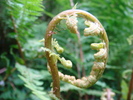
|
Chart of fern families: Interpretation |

|
Home |
View chart |
Guide |
Availability |
How to interpret the chartThe chart depicts a recently developed phylogeny of all living ferns. The disks represent families of ferns. Groups of related families are indicated by a hierarchy of regions and some of these groups are named. For more than 250 years, families of plants and relationships between families were determined mainly by morphology (the structure, shape and number of plant parts). Since the 1990s, genetic information has become available and now the affinity of species, genera and families is determined primarily by this molecular evidence. The previous morphological classifications were, to some extent, supported by the molecular analysis. However, major changes have been necessary both to the circumscription of some families and to the placement of families relative to each other and to the corresponding higher groupings. The chart is based on the recent work aimed at resolving the molecular phylogeny of ferns (see the bibliography below). The chart depicts a phylogenetic tree in terms of a hierarchical grouping of families. Many of these placements are now well-established, but uncertainties remain - these we have tried to indicate on the chart (see below for details of how uncertain placements are depicted). The chart will be updated as new results become available. |
Phylogenetic treesThe chart corresponds to a phylogenetic tree. Regions on the chart, delimited by boundaries or shaded areas, correspond to nodes in a tree, and families, as disks on the chart, are leaves of the tree. In trees, proximity of two families is represented by the depth of the root of the smallest subtree containing the two families. Here it is represented by a shared region. Proximity does not cross boundaries: families close on the chart but separated by a boundary are no closer than their common region indicates. Boundaries are depicted with varying styles and colours - this is merely to aid the eye and has no phylogenetic significance. UncertaintiesMany of the placements of families are now well-established and much work has been done to resolve remaining issues. However, uncertainties remain. The chart is not intended to be a resolution of these. Where evidence is poor, we have either (a) left relationships unresolved (as a `polytomy'), or (b) chosen the best supported on current evidence, or (c) indicated alternative placements. On the whole, we have been conservative in the depiction of family relationships. As new evidence appears, new versions of the chart will be published. NomenclatureCommon names: Common, or vernacular, names (in English) are used to describe some familiar ferns. These names vary from language to language. This is particularly a problem when only local names are available. In addition, the same common name may be used for several (sometimes unrelated) species. Occasionally, these ambiguous names have been used but accompanied by the relevant genus. In all, common names on the chart should be treated with caution. AgesSome extant fern families appear to originate as far back as the Carboniferous period. For example, there are Carboniferous fossil ferns with marattioid (Marattiaceae) characters. However, there have been several more recent periods of fern development giving rise to other extant families, with some families in the Polypodiales, for example, appearing in the late Mesozoic. Of course, the vast majority of fern species are extinct, and with them are lost many aspects of fern diversity. One of the curiosities of the fossil record of ferns is that some extant species seem to have remained unchanged for very long periods. For example, there are fossils from ~75Mya which appear to be identical to Osmundastrum cinnamomeum (= Osmunda cinnamomea) and fossils from ~57Mya which appear to be Onoclea sensibilis. For recent summaries of fern paleontology (and the relationship to phylogeny), see:
Chart detailsThe chart is designed to be viewed at A3 size (29.7cm × 42.0cm, 11.75in × 16.5in) or larger. If viewing in PDF, you may change the magnification in order to view and navigate the chart. Personal noteThis series of charts was prepared with the personal objective of creating attractive visual aids and, to some extent, informative displays for my own use. Early versions were prepared before the advent of molecular systematics and used morphological classifications and a display inspired by that of Stebbins (Flowering Plants: Evolution above the Species Level, G.L. Stebbins. The Belknap Press, Harvard University Press, Cambridge, Mass. 1974) extended to the family level. With the development of molecular phylogenies, considerable redesign was required, including now much 'fine-structure' in the relationship of families. I have decided to make the current versions generally available. I hope that these are found as useful and as attractive as I intended. The charts will be updated as new results become available. Printed versions of this fern chart (A3 size) are available. For a chart of flowering plant families, visit the Angiosperm page. David Rydeheard (2011) Source papersRecent resources for fern phylogeny include:
A useful dictionary of families and genera is:
A large bibliography (concentrating on flowering plants) can be found on the Angiosperm Phylogeny Website. Related websites
ContactsThe chart and website were developed by David Rydeheard. To contact me with comments, corrections or any other matters concerning this site, please email me at BotanicalChart@gmail.com. |
|
The chart is designed by David Rydeheard, who owns the copyright. It should not be distributed in any form other than that available on this website and must always include the copyright notice. It is available for personal use or for teaching and research purposes only. Please contact the author (at BotanicalChart@gmail.com) for permission to use in commerce or for personal gain. |